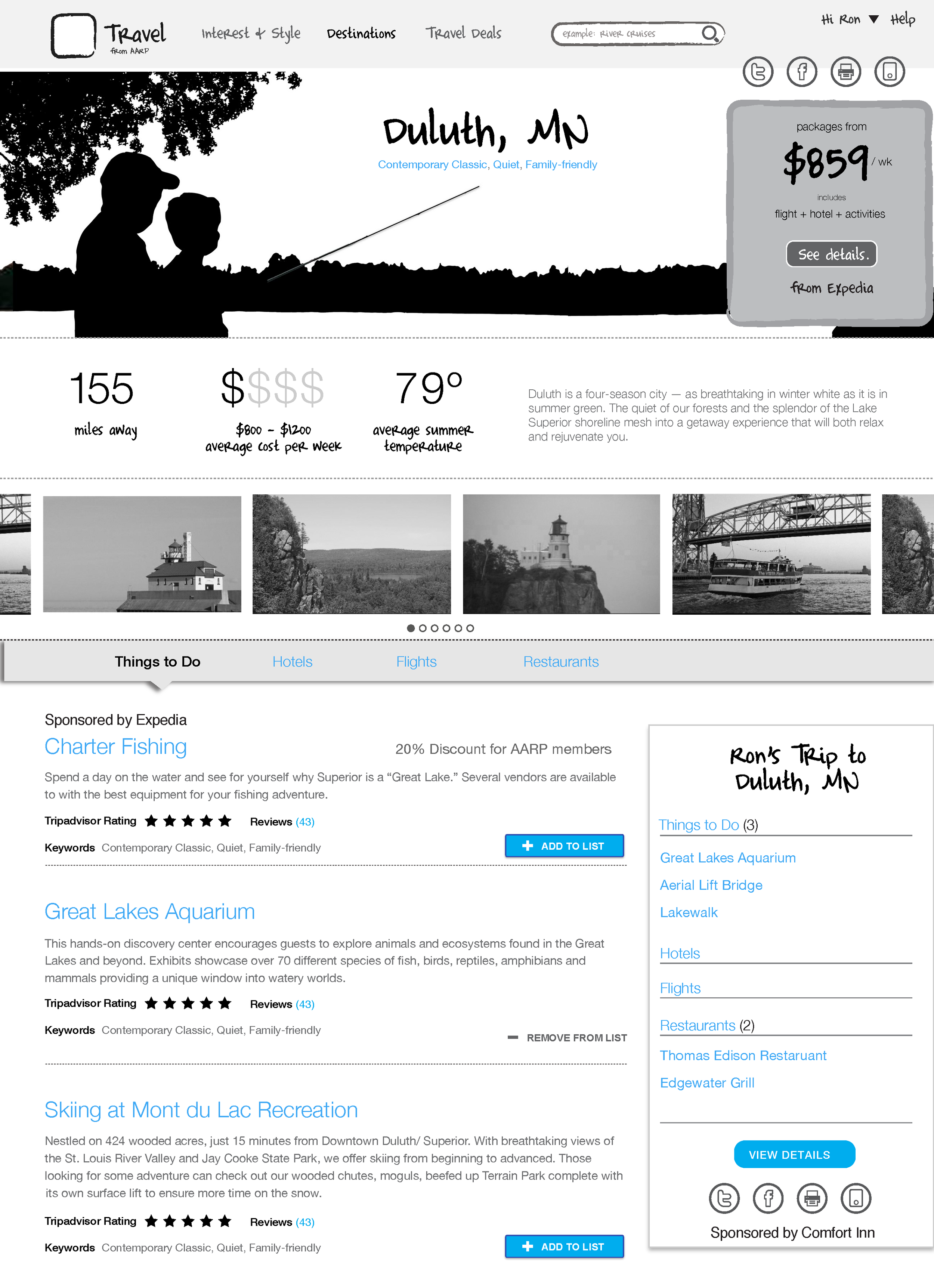Overview
AARP, formerly known as the American Association of Retired Persons, is a powerful nonprofit with a mission to enhance the quality of life for adults aged 50 years and above. The association advocates for issues pertinent to aging populations and delivers value to members through information, discounts, and community service.
With the average US life expectancy nearing 80 years, many Americans have decades of active life to enjoy after retirement. And travel is the #1 aspirational goal for AARP members.
In close collaboration with Strategy Director, Barbara Pantuso, I led a cross-functional team in discovering insights and creating experiences to richly demonstrate a vision for how AARP can transform travel for the over-50 crowd.
Our work has been rolled out in phases over the last few years, corresponding with a significant increase in AARP memberships and a 120% year-to-year (2013-2014) increase in traffic to the AARP Travel website.

Business Insights
AARP, Real Possibilities
In 2013, AARP embarked on a rebrand aimed at reframing perceptions about about what it means to be part of the older adult population.
"AARP is shifting the focal point of the conversation from aging and advice, to a deeper level of personal connection and empowerment. People age 50+ don’t want to be defined by age, and they don’t want to live in fear that their possibilities become more limited as they get older.”
~ AARP Press Center. 26 February 2013.
Business Context
In order to understand business needs and market forces for how AARP Travel would work toward moving the orgainzation forward we interviewed 28 stakeholders and reviewed a variety of research materials. As part of the rebranding effort AARP conducted several quantitative studies about the younger AARP audience and their general appetite for an AARP Travel experience.
Key Insights
- Americans over 50 spent $120 billion each year on travel, as of 2013.
- Americans over 50 reported that travel was their #1 aspirational goal.
- Travel discounts were reported as the #1 driver of AARP membership renewals.
- Display advertisements, cobranded experiences, and partner services provided a significant source of revenue for AARP Travel.
AARP Travel Business Imperatives
- Create unique value to 50+ travelers with experiences and services designed for their specific needs.
- Encourage AARP membership and renewal.
- Increase engagement with display advertisements, sponsorships, and co-branded experiences.
- Create a plan to coordinate AARP Travel and partner co-branded domains in one cohesive user experience, while keeping respective digital properties distinct.
- Increase engagement on all channels with a focus on how mobile and social media channels can play a critical role.
Market Assessment
To identified gaps and opportunities in the 50+ travel market we reviewed 38 direct competitors, potential partners and beacon digital experiences.
Key Insights
- No travel website or app specifically addresses the 50+ audience's interests, concerns, and/or unique travel needs.
- Discount providers, like AAA, provide very similar discounts to AARP making discounts a poor market differentiator.
- Competitors have little cohesion or coordination among tools, social media, and mobile channels.
AARP Travel Market Opportunities
- AARP was uniquely positioned to leverage its brand recognition and reach to extend a more unique offering to 50+ travelers.
- AARP must move beyond discounts in order to provide differentiated value to users.

User Insights
Ethnography
As part of the rebranding effort, AARP conducted quantitative and market research. This research provided insights about demographic trends and how various cohorts view the AARP brand we still needed to understand the motivations and frustrations of our 50+ traveler. Our team conducted in-home interviews of 8 potential users, asking them about their travel styles, needs, and attitudes.
Key Behaviors and Attitudes
- Older adults are all somewhat tech-savvy using computers, tablets and smart phones for a wide range of daily activities, including planning and booking travel.
- The 50+ age audience does more "everyday travel." That means they're more likely to drive an hour or so and enjoy what's nearby their home. For the younger end of the age spectrum, everyday travel was driven by obstacles to big trips: family obligations and time constraints. For the older retirees, their abundance of free time meant everyday travel was something worked into each week.
- Family and group travel are predominant. Some family travel is obligatory, like regular visits to non-local family or traveling to family events. Other family travel has this audience acting as the planner or sponsor for "once in a lifetime" family trips.
- Costs and discounts are essential to travel planning. AARP discounts are appreciated, though most travelers shopped around for the best discount with little to no loyalty to a particular source.
Personas
Combining AARP's quantitative insights with our first-hand experiences talking to users, we were able to sketch out two personas who represented two different kinds of AARP travelers. One one end of the spectrum was AARP's new target, the 50 year old who is time constrained by family and career obligations. She dreamed of taking big trips, but most often she ended up engaged in more local trips and obligatory travel. Our other persona was a traditional AARP member, officially retired with an abundance of time to take very frequent local trips and the occasional dream trip.
User Journeys
In conjunction with creating our personas, we used our ethnographic studies to map the end-to-end travel experience for our audience. In doing so we were able to identify where users needed the most help, when they were confused or unsure, and where AARP Travel could provide unique value to fill the gaps in the existing experience.
Pain Points
- During the planning stage, 50+ travelers were frustrated when trying to find what was right for their unique travel needs. Review sites buried ideas and information pertinent to the 50+ travelers specific needs. So they tended to sift through several different resources to find user reviews from people like them.
- When booking they also shopped around from several different sources to find the lowest price for each piece of the planning.
- The entire process of preparing for a trip took too much effort. The abundance of options was often overwhelming and it took a great deal of effort to keep it all straight.
- Planning and sharing group travel was difficult to coordinate on all stages of travel.

Design Concepts
Synthesis of Discovery Findings
Combining business insights with user insights, we identified 7 imperatives to guide our design approach for how the AARP Travel Vision Prototype could provide a unique value in solving the frustrations of the 50+ traveler.
UX Imperatives
- Simplify the landscape for travel planning by providing content and resources customized to the 50+ traveler.
- Help the user filter options with user reviews and perspectives from other 50+ travelers.
- Provide a central location to store travel research, planning, and itineraries.
- Inspire travelers with ideas for everyday travel to nearby destinations.
- Encourage social sharing at all stages of travel.
- Facilitate group travel or social travel experiences.
- Design for the tech-savvy 50+ who uses all platforms and devices.
- Incorporate discounts, advertisers, and co-branded experiences in a way that provides value to the user in context with what she is trying to achieve.
Thanks to my stellar team, credited alongside their work below.
Concept 1: Trips I Love
This concept focused on simplifying the landscape of options, by providing custom destinations an itineraries with filters designed around the 50+ traveler. This concept also emphasized local travel, or everyday travel. Images by Thomas H., Karelia M., and me.
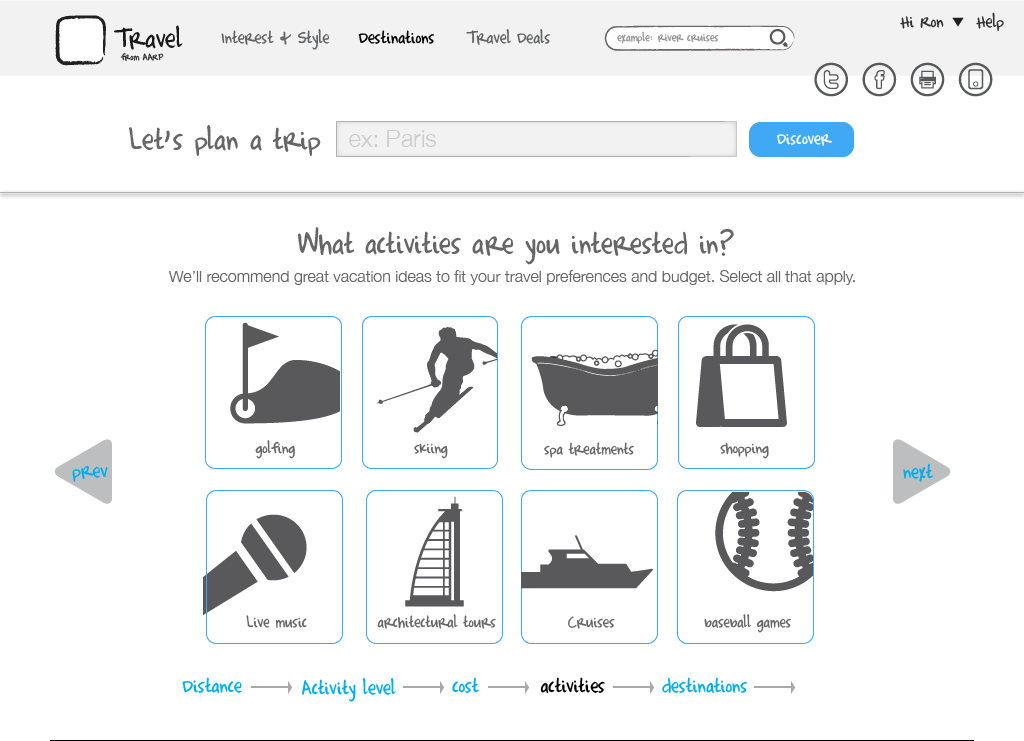
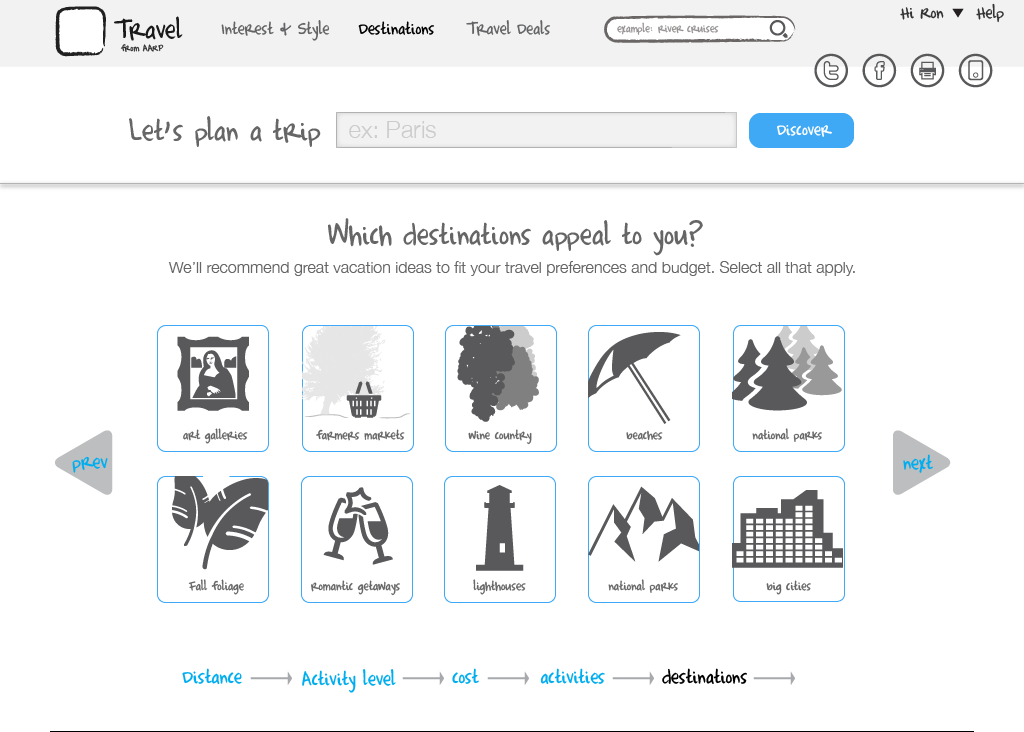
Marquee Features
- Taste profile quiz provided custom destinations and itinerary ideas based on quiz answers. We explored many variations of quiz questions including activity level, group travel size, cost, duration, health care availability, accessibility, and distance from home.
- Reviews from the AARP community could help users sort out destinations and itinerary options.
- Everyday travel destinations were featured in the destination results.
- The ability to save destinations and trip ideas to one location helped organize the planning stage.
Concept 2: Group Travel Booker
This concept focused on the business need of incorporating discounts, advertisers, and co-branded experiences in a way that would provide value to the when planning and booking a group trip. Images by me.
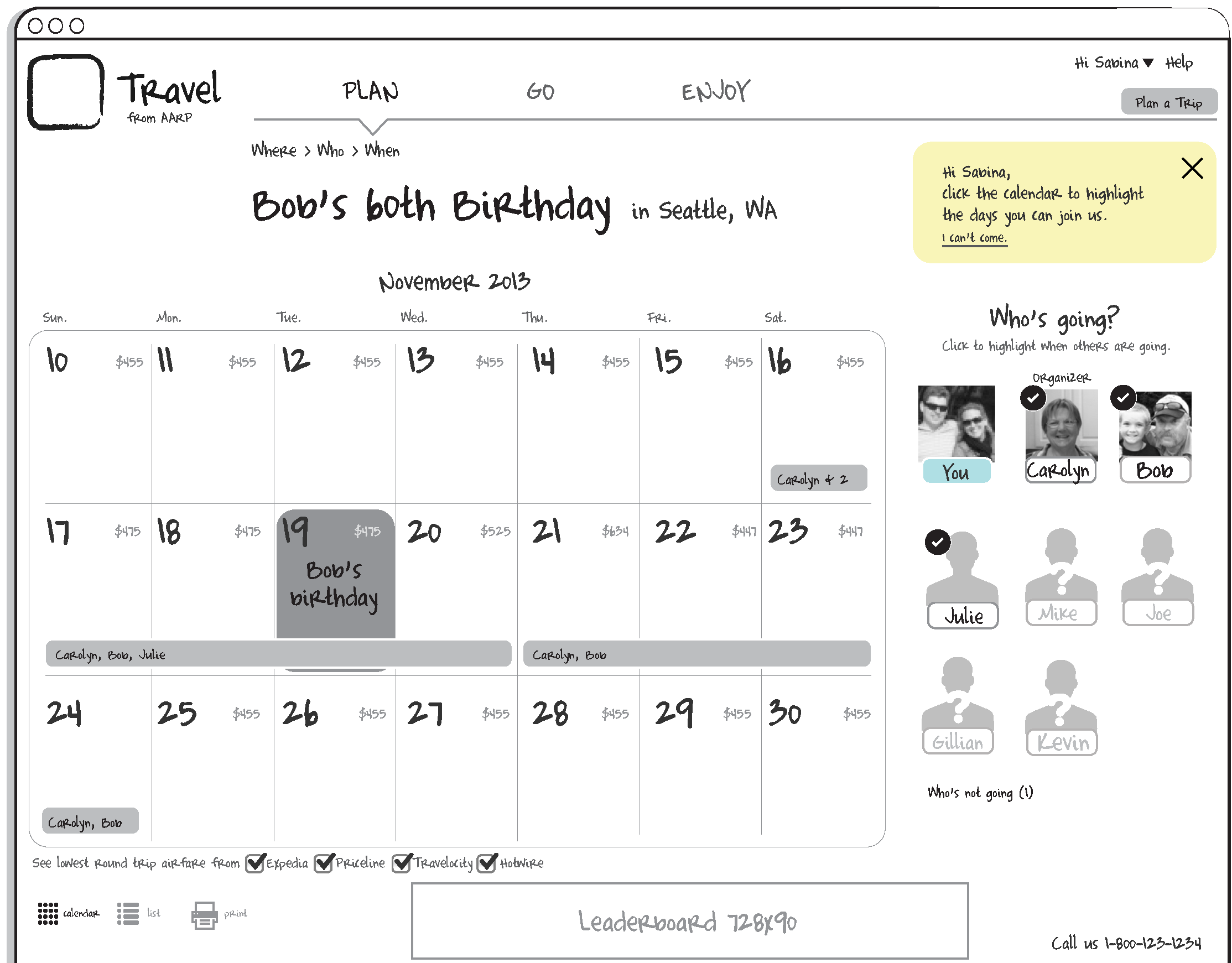
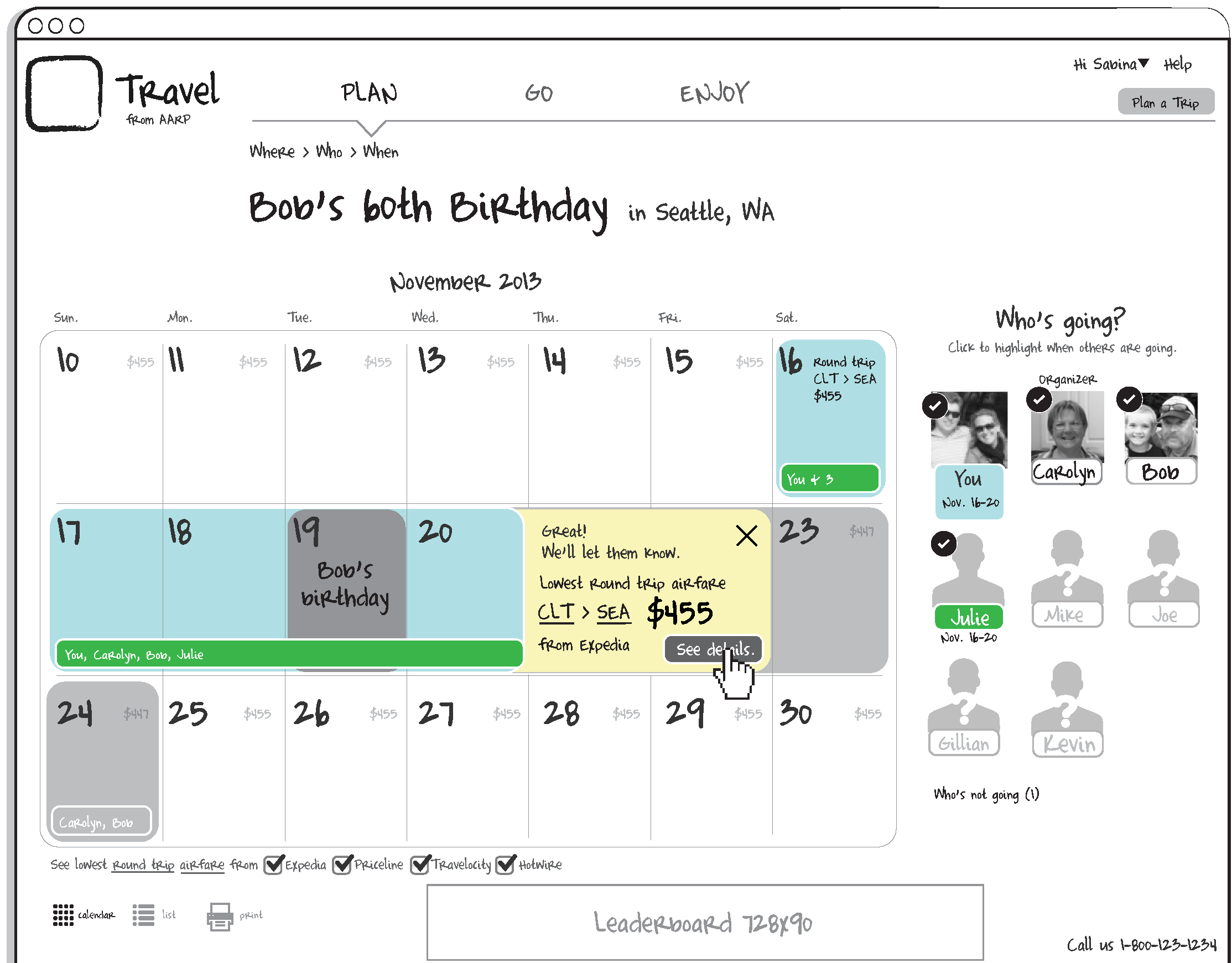
Marquee Features
- Shared travel calendar helps groups coordinate travel dates one shared calendar. You can easily see who is attending a group travel event and what dates each person will attend.
- Partner offers for and discounts are provided when the user selects a date range for travel. Travel deals could be viewed by adjusting dates or combining travel with others for group discounts.
Concept 3: Travel Toolkit
This concept worked with a range of user-centered features that could be partner provided or sponsored. Below is an example of an feature where photos taken on a trip could be shared via social media or AARP Travel's website. The images could also be printed using a partner service like Shutterfly. Image created by Anthony Z.
Marquee Features
- AARP Travel could be a platform where various tools could be integrated into an end-to-end travel experiences.
- The platform would provide opportunities for increased engagement with partner-branded content and experiences.
- Toolkit could be focused on the on-trip experience and therefore designed with a mobile-first approach. This could include on-trip mobile alerts, itinerary reminders, nearby landmarks, interests, highly reviewed spots. (not shown)

Concept Testing
Workshopping with the Users
Key Workshop insights
Our next step was to take our ideas to potential users and assess product-market fit. The team did this by conducting workshop-style focus groups where each idea was discussed and expanded upon.
Concept 1: "Trips I Love"
This concept was the most appreciated by users, since it provided customized recommendations based on our 50+ travelers' needs. Various filters and facets were discussed and refined in the workshop setting.
Concept 2: "Group Travel Booker"
This concept was appealing, though most said they would still use other websites to confirm which discount was best when doing the actual booking. Despite being my personal favorite, the group travel calendar and booker features were not pursued.
Concept 3: "Travel Toolkit"
All users were excited about the idea of mobile alerts and social sharing tools, especially since the community aspect included users like them.

Outcome
Our vision prototype was well received by the client, who has been building out features on a rolling timeline. Our work gave AARP Travel a significant bump in traffic, increasing year-over-year page views by 120%.






